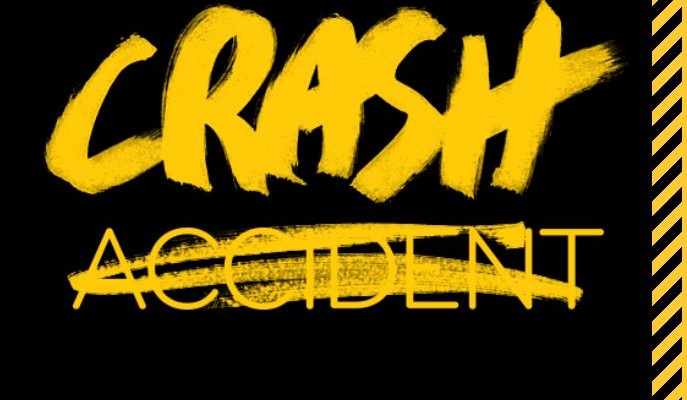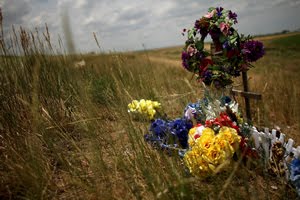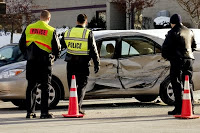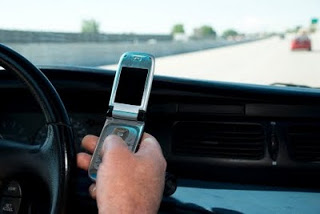Tag Archive: motor vehicle crashes

There’s No Such Thing As A Traffic Accident!
August 26, 2015
There’s no such thing as a traffic accident! We have written on this before but it bears repeating; especially for young drivers. Before anyone tries to tell us we’re crazy, let’s take a look at the meaning of the word accident.
The dictionary defines an accident as “an unfortunate incident that happens unexpectedly and unintentionally, typically resulting in damage or injury.”
An accident is a situation that we have no control over. If you’re struck by lightning or a tree limb falls and hits you in the head, that’s an accident. However, where there’s a motor vehicle crash, it’s rarely an accident; it was caused.
Motor vehicle crashes are caused when one or more drivers make a poor choice and that poor choice leads to a crash. Driving too fast to safely react to road conditions ahead or running a red light are examples of the poor choices that drivers make and they aren’t accidents; they are deliberate choices made by the driver. Even allowing yourself to be distracted and not paying attention to the road ahead is a choice that a driver makes and it can easily lead to a crash but not to an accident.
As drivers, we have choices and we can either choose to drive safely, pay attention to the road ahead, and use caution when potentially dangerous situations come up ahead. Or, we can choose to speed, run red lights, send text messages, or just allow our minds to wander and not pay attention to what may be ahead of us. The crash may be unintentional but the driver’s poor choice caused it. As drivers, the choices are ours and ours alone and can’t be blamed on some outside force.
Of course, if you’re driving safely and obeying all the traffic laws and someone hits you, from your perspective, the situation would qualify as an accident but, for the other driver who hit you as the result of a poor choice he or she made, it wasn’t an accident at all.
So what about bad weather events? Can’t bad weather cause accidents? It all depends on how the driver reacts to the bad weather. Did he or she continue to drive at normal speeds in a heavy fog or fail to realize that there may be patches of slick ice on the road? Did the driver slow down or get off the road to wait for a heavy rain storm to pass? Weather can cause accidents but, more often than not, it was the poor choice of how the driver reacted to the bad weather that causes a crash.
An organization called Families for Safe Streets is calling for people to stop using the word accident when it comes to motor vehicle crashes. The organization is made up of people who have lost loved ones in motor vehicle crashes and they want to spread the word that they didn’t lose their loved one due to an accident. They want it known that a driver made the choice to take the actions that led to the death of their loved one.
Families for Safe Streets is conducting a drive to educate people that there are no motor vehicle accidents and the word “crash” should be used instead. If you agree, they’re asking you to sign a pledge and help spread the word to stop using the word accident when motor vehicles are involved.
To sign the pledge, go to: I will not call traffic crashes “accidents.” I will educate others about why “crash” is a better word.

Survivor’s Guilt: Teens in Motor Vehicle Crashes
February 21, 2012
A single car crash in North Carolina last month led to the death of the driver’s twin sister.
Another news report from the past month regarding a teen who had been killed in a single vehicle car crash the teen’s girl friend was quoted as saying:
“Cameron was drinking and we got into a fight. I told him to find another ride home. I said, ‘Get out of this car, you’re being disrespectful,'” Talia said, gasping between tears and raising her arms to the sky. “Why didn’t I drive him home?”
Survivor’s guilt, which is most often associated with victims of combat, can occur in anyone who has survived any type of trauma whether they were directly involved or not. The guilt from wishing they had done something different that may have averted the event can lead to long-lasting psychological problems. The most common form of psychological trauma resulting from survivor’s guilt is Post Traumatic Stress Disorder (PTSD) which can result in life-long, debilitating problems for the victim. This is why high schools, who experience the death of one of their students, make extra counselors available to the student body immediately after the event.
If your teen has been involved in a crash in which someone died or was horribly injured or even if they were weren’t involved but were closely associated with the victim, you will need to help them through the grief process and you should be on the lookout for the warning signs of PTSD.
Grief – The grief process is something everyone who has experienced the loss of a friend or loved one must go through and it occurs in specific stages;
- Denial and Isolation.
- Anger.
- Bargaining.
- Depression.
- Acceptance.
Guiding your teen through all of the stages to acceptance, can be a long and painful process. If the guilt is left unresolved, it can lead to a multitude of psychological issues.
Don’t try to tell your teen how they should act or feel – No one can truly understand how a grieving person feels and trying to tell them their emotions are wrong or unhealthy can only compound the problem. Instead, sympathize and let him or her vent their feelings. Holding in or suppressing one’s feelings can be harmful.
Suggest that they express their grief in a creative way – One example of a creative expression of grief is the Facebook page mentioned in the first article of this newsletter. Writing a song or a poem, creating a memorial to the victim are all positive expressions of grief. Getting involved in programs to prevent future tragedies can give your teen some sense of control over events.
Watch for signs that your teen may be “numbing out” – One common expression of grief is to try to suppress the feelings by turning to alcohol or drugs. This is an especially dangerous form of expression and can only make matters worse.
Withdrawing from friends and events – Your teen my stop engaging in their usual activities or back away from friendships. This part of the denial and isolation stage is designed to prevent any future relationships and thus, the chance of losing someone else that may be close to them. To make up for the lack of relationships, your teen may turn to alcohol or drugs or withdraw into video games. Their school performance may suffer.
Grief Triggers – There will be times when reminders of the loss of their friend will be especially acute; such as anniversaries of the event, birthdays, school proms, graduation. Be aware of these triggers and be prepared to help your teen through the grief process all over again.
Talk, talk, talk, talk, talk – Trying to put the past behind you by ignoring the fact that the event happened won’t make it go away. Talking through the issues is the best form of grief expression. Be there for your teen, allow them to talk it out and listen without judging.
Don’t be afraid to seek professional counseling – Unresolved, PTSD can lead to severe depression, paranoia, isolation, and drug dependence. If left unresolved, these issues can affect future generations. Be on the lookout for warning signs and understand that the issues may be too big for you to handle. Seek professional psychological help.

Texting and Driving: What happens when a vehicle comes in your lane.
January 20, 2012
You can read about it several times a week; a driver who is either texting, using a cell phone, or engaged in some other form of distracted driving, drifts over into the oncoming lane causing a crash. This type of crash is becoming all too common and unfortunately, death is often the result. Head-on crashes are the worst type of crash with the greatest potential for serious injuries and death. However, a driver in your lane doesn’t automatically have to result in a head-on crash if you are prepared.
To be prepared for the unexpected drivers should always use the S.I.P.D.E method of defensive driving. That is:
- Search the driving scene – Always be aware of what is happening in front of you, to the sides, and behind.
- Identify hazards – Be on the lookout for anything that could be a potential hazard whether that be a driver about to pull out of a parking lot or a driver ahead who is obviously distracted and isn’t looking at the roadway.
- Predict what may happen – When trying to predict what the other driver might do, in order to best prepare yourself, always predict the worst thing that could possibly happen.
- Decide what you will do – Having a decision already in mind if that other driver should do the worst will allow you additional precious time to escape a collision situation.
- Execute your decision – If the worst thing happens, you will have to put your plan into action in order to escape a collision.
Note: Sometimes you may not be able to completely escape a collision, when planning and executing your decision, you may have to choose to lessen the crash forces rather than escape a crash altogether.
If a driver ahead should suddenly swerve into your lane, you may have very few choices but, to avoid or reduce the severity of the crash, follow these tips:
- Honk your horn to alert the other driver.
- Don’t try to swerve to the left into his lane to avoid a crash, he may realize what he is doing and try to swerve back into his lane at the same time.
- Rather than face a head-on crash, it is better to go off the road to the right. There may be hazards there too so steer to avoid them and try to quickly slow to a stop. It is better to go into some bushes than to crash into something hard.
- Sometimes you may face the very tough choice of hitting a car on the right to avoid a head-on crash. Hitting a vehicle that is going in the same direction as you, while still very serious, is often safer than facing a head-on crash.

Teen Driver Safety – When the Crash Isn’t Avoided
June 23, 2010
More often than not, teenagers are taught how to avoid vehicle crashes as opposed to correct procedures if they are ever a crash. Obviously, new drivers are taught defensive driving techniques to ensure their safety on the roadways and to minimize their risks. However, odds are that most teenagers will be involved in at least a minor crash.
The period of time between Memorial Day Weekend and Labor Day is when the most teenagers are involved in vehicular crashes. Below, you will find a basic checklist of things you should go over with your teenager to provide a better understanding of what to do after as well as the insurance aftermath from the crash.
- Discuss insurance basics: If you haven’t already explained to your teenager how insurance rates and premiums work, this is probably a good place to start. Explain why it costs much more to insure an experienced driver and explain the savings associated with a good driving record.
- Consider a contract: A teen driving contract would outline what is expected of the teenager (i.e. safe driving practices, curfews, etc). It would also outline who would cover the rise in insurance costs following a crash and any other consequences your teenager would face as a result of failing to live up the expectations you outlined.
- Insurance and Registration should be in the glove box: Make sure your teenager knows to have the insurance card and registration in a place that is easily accessible and won’t get lost. The glove box is the ideal place.
- Some additional things to consider keeping on hand: A small first-aid kit, self-lighting emergency flares, a disposable camera, a small notebook and a pen to take down another driver’s contact information, and lastly, names/numbers for rescue personnel to contact.
- Document the Crash: Photograph the incident, even if there is minimal damage. If you don’t have a disposable camera in your car the camera on your phone will suffice. If there were any witnesses make sure to get their names and numbers. Witnesses can help you sort out details later.
- File a police report: it is best to file a police report and have it recorded. This is the choice of both drivers to determine even if it was just a fender bender.
- Don’t place blame: Getting involved in a game of finger pointing with another driver is never a good idea. Instruct your teenager to wait in the vehicle until the police arrive if the other driver is trying to confrontational. No good can come from getting in a fight with the other driver.
Even if you think you were at fault, you may not be. That’s why insurance agents recommend that you not accept fault or blame at the scene. It is best to let the police officer sort it out.

